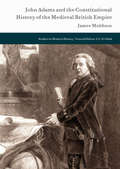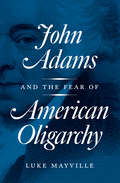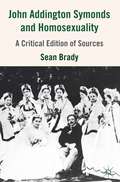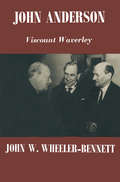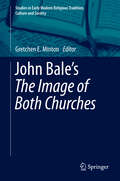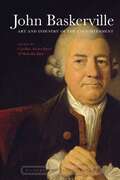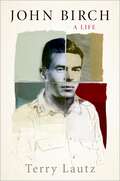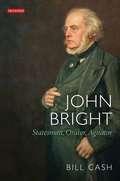- Table View
- List View
John Adams and the Constitutional History of the Medieval British Empire
by James MuldoonThis book contributes to the increasing interest in John Adams and his political and legal thought by examining his work on the medieval British Empire. For Adams, the conflict with England was constitutional because there was no British Empire, only numerous territories including the American colonies not consolidated into a constitutional structure. Each had a unique relationship to the English. In two series of essays he rejected the Parliament’s claim to legislate for the internal governance of the American colonies. His Dissertation on the Canon and Feudal Law (1765) identified these claims with the Yoke, Norman tyranny over the defeated Saxons after 1066. Parliament was seeking to treat the colonists in similar fashion. The Novanglus essays (1774-75), traced the origin of the colonies, demonstrating that Parliament played no role in their establishment and so had no role in their internal governance without the colonists’ subsequent consent.
John Adams and the Fear of American Oligarchy
by Luke MayvilleLong before "the one percent" became a protest slogan, American founding father John Adams feared the power of a class he called simply “the few”—the wellborn, the beautiful, and especially the rich. In John Adams and the Fear of American Oligarchy, Luke Mayville presents the first extended exploration of Adams's preoccupation with a problem that has a renewed urgency today: the way in which inequality threatens to corrode democracy and empower a small elite. By revisiting Adams’s political writings, Mayville draws out the statesman’s fears about the danger of oligarchy in America and his unique understanding of the political power of wealth—a surprising and largely forgotten theory that promises to illuminate today’s debates about inequality and its political consequences.Adams believed that wealth is politically powerful in modern societies not merely because money buys influence, but also because citizens admire and even sympathize with the rich. He thought wealth is powerful in the same way that beauty is powerful—it distinguishes its possessor and prompts reactions of approval and veneration. Citizens vote for—and with—the rich not because, as is often said, they hope to be rich one day, but because they esteem the rich and submit to their wishes. Mayville explores Adams’s theory of wealth and power in the context of his broader concern about social and economic inequality, and also examines his ideas about how oligarchy might be countered.A compelling work of intellectual history, John Adams and the Fear of American Oligarchy also has important lessons for today’s world of increasing inequality.
John Adams and the Fear of American Oligarchy
by Luke MayvilleLong before "the one percent" became a protest slogan, American founding father John Adams feared the power of a class he called simply “the few”—the wellborn, the beautiful, and especially the rich. In John Adams and the Fear of American Oligarchy, Luke Mayville presents the first extended exploration of Adams's preoccupation with a problem that has a renewed urgency today: the way in which inequality threatens to corrode democracy and empower a small elite. By revisiting Adams’s political writings, Mayville draws out the statesman’s fears about the danger of oligarchy in America and his unique understanding of the political power of wealth—a surprising and largely forgotten theory that promises to illuminate today’s debates about inequality and its political consequences.Adams believed that wealth is politically powerful in modern societies not merely because money buys influence, but also because citizens admire and even sympathize with the rich. He thought wealth is powerful in the same way that beauty is powerful—it distinguishes its possessor and prompts reactions of approval and veneration. Citizens vote for—and with—the rich not because, as is often said, they hope to be rich one day, but because they esteem the rich and submit to their wishes. Mayville explores Adams’s theory of wealth and power in the context of his broader concern about social and economic inequality, and also examines his ideas about how oligarchy might be countered.A compelling work of intellectual history, John Adams and the Fear of American Oligarchy also has important lessons for today’s world of increasing inequality.
John Adams and the Fear of American Oligarchy
by Luke MayvilleLong before the "one percent" became a protest slogan, American founding father John Adams feared the power of a class he called simply "the few"—the wellborn, the beautiful, and especially the rich. In John Adams and the Fear of American Oligarchy, Luke Mayville explores Adams’s deep concern with the way in which inequality threatens to corrode democracy and empower a small elite. Adams believed that wealth is politically powerful not merely because money buys influence, but also because citizens admire and even identify with the rich. Mayville explores Adams’s theory of wealth and power in the context of his broader concern about social and economic disparities—reflections that promise to illuminate contemporary debates about inequality and its political consequences. He also examines Adams’s ideas about how oligarchy might be countered. A compelling work of intellectual history, John Adams and the Fear of American Oligarchy has important lessons for today’s world.
John Adams and the Fear of American Oligarchy
by Luke MayvilleLong before the "one percent" became a protest slogan, American founding father John Adams feared the power of a class he called simply "the few"—the wellborn, the beautiful, and especially the rich. In John Adams and the Fear of American Oligarchy, Luke Mayville explores Adams’s deep concern with the way in which inequality threatens to corrode democracy and empower a small elite. Adams believed that wealth is politically powerful not merely because money buys influence, but also because citizens admire and even identify with the rich. Mayville explores Adams’s theory of wealth and power in the context of his broader concern about social and economic disparities—reflections that promise to illuminate contemporary debates about inequality and its political consequences. He also examines Adams’s ideas about how oligarchy might be countered. A compelling work of intellectual history, John Adams and the Fear of American Oligarchy has important lessons for today’s world.
John Adams, Slavery, and Race: Ideas, Politics, and Diplomacy in an Age of Crisis
by Arthur ScherrProviding the first full investigation of second U.S. president John Adams' attitudes toward slavery, blacks, and the Haitian Revolution, this iconoclastic study illuminates the inner and outer worlds of Adams for scholars and general readers.John Adams was a Founding Father of the United States who not only played a key role in laying the foundation of the nation but is also highly regarded as a great speaker, thinker, lawyer, revolutionary, diplomat, vice president, and president. But was Adams an opponent of slavery and a believer in racial equality? The historical evidence points to the contrary.This book is the first to discuss at any length John Adams's views on race, slavery, and slavery extension by examining his writings, politics, and diplomacy. Historian Arthur Scherr, an expert who is uniquely knowledgeable about Adams's views on slavery, race, and the Haitian Revolution, reveals Adams's attitudes toward slavery and race in and out of office, spotlighting his views on slavery during the American Revolution, his perspective regarding race as vice president and president of the United States, and his opinions in retirement.Readers will be able to form their opinions based on factual documentation of Adams's statements and actions regarding the key events involving slavery and race during this period: the gradual emancipation of slaves; U.S. aid to Haiti, the only black-governed nation in the world, and to its Governor-General Toussaint Louverture in gaining its independence; and the U.S. government's decision to permit slavery in new states and territories formed from public lands such as the Old Northwest and the Louisiana Purchase.
John Adams, Slavery, and Race: Ideas, Politics, and Diplomacy in an Age of Crisis
by Arthur ScherrProviding the first full investigation of second U.S. president John Adams' attitudes toward slavery, blacks, and the Haitian Revolution, this iconoclastic study illuminates the inner and outer worlds of Adams for scholars and general readers.John Adams was a Founding Father of the United States who not only played a key role in laying the foundation of the nation but is also highly regarded as a great speaker, thinker, lawyer, revolutionary, diplomat, vice president, and president. But was Adams an opponent of slavery and a believer in racial equality? The historical evidence points to the contrary.This book is the first to discuss at any length John Adams's views on race, slavery, and slavery extension by examining his writings, politics, and diplomacy. Historian Arthur Scherr, an expert who is uniquely knowledgeable about Adams's views on slavery, race, and the Haitian Revolution, reveals Adams's attitudes toward slavery and race in and out of office, spotlighting his views on slavery during the American Revolution, his perspective regarding race as vice president and president of the United States, and his opinions in retirement.Readers will be able to form their opinions based on factual documentation of Adams's statements and actions regarding the key events involving slavery and race during this period: the gradual emancipation of slaves; U.S. aid to Haiti, the only black-governed nation in the world, and to its Governor-General Toussaint Louverture in gaining its independence; and the U.S. government's decision to permit slavery in new states and territories formed from public lands such as the Old Northwest and the Louisiana Purchase.
John Adams's Republic: The One, the Few, and the Many
by Richard Alan RyersonScholars have examined John Adams;€™s writings and beliefs for generations, but no one has brought such impressive credentials to the task as Richard Alan Ryerson in John Adams;€™s Republic. The editor-in-chief of the Massachusetts Historical Society;€™s Adams Papers project for nearly two decades, Ryerson offers readers of this magisterial book a fresh, firmly grounded account of Adams;€™s political thought and its development.Of all the founding fathers, Ryerson argues, John Adams may have worried the most about the problem of social jealousy and political conflict in the new republic. Ryerson explains how these concerns, coupled with Adams;€™s concept of executive authority and his fear of aristocracy, deeply influenced his political mindset. He weaves together a close analysis of Adams;€™s public writings, a comprehensive chronological narrative beginning in the 1760s, and an exploration of the second president;€™s private diary, manuscript autobiography, and personal and family letters, revealing Adams;€™s most intimate political thoughts across six decades.How, Adams asked, could a self-governing country counter the natural power and influence of wealthy elites and their friends in government? Ryerson argues that he came to believe a strong executive could hold at bay the aristocratic forces that posed the most serious dangers to a republican society. The first study ever published to closely examine all of Adams;€™s political writings, from his youth to his long retirement, John Adams;€™s Republic should appeal to everyone who seeks to know more about America;€™s first major political theorist.
John Adams's Republic: The One, the Few, and the Many
by Richard Alan RyersonScholars have examined John Adams;€™s writings and beliefs for generations, but no one has brought such impressive credentials to the task as Richard Alan Ryerson in John Adams;€™s Republic. The editor-in-chief of the Massachusetts Historical Society;€™s Adams Papers project for nearly two decades, Ryerson offers readers of this magisterial book a fresh, firmly grounded account of Adams;€™s political thought and its development.Of all the founding fathers, Ryerson argues, John Adams may have worried the most about the problem of social jealousy and political conflict in the new republic. Ryerson explains how these concerns, coupled with Adams;€™s concept of executive authority and his fear of aristocracy, deeply influenced his political mindset. He weaves together a close analysis of Adams;€™s public writings, a comprehensive chronological narrative beginning in the 1760s, and an exploration of the second president;€™s private diary, manuscript autobiography, and personal and family letters, revealing Adams;€™s most intimate political thoughts across six decades.How, Adams asked, could a self-governing country counter the natural power and influence of wealthy elites and their friends in government? Ryerson argues that he came to believe a strong executive could hold at bay the aristocratic forces that posed the most serious dangers to a republican society. The first study ever published to closely examine all of Adams;€™s political writings, from his youth to his long retirement, John Adams;€™s Republic should appeal to everyone who seeks to know more about America;€™s first major political theorist.
John Addington Symonds (1840-1893) and Homosexuality: A Critical Edition of Sources
by S. BradyThe book brings together for the first time John Addington Symonds' key writings on homosexuality, and the entire correspondence between Symonds and Havelock Ellis on the project of Sexual Inversion. The source edition contains a critical introduction to the sources.
John Armstrong's The Art of Preserving Health: Eighteenth-Century Sensibility in Practice
by Adam BuddJohn Armstrong's 2000-line poem The Art of Preserving Health was among the most popular works of eighteenth-century literature and medicine. It was among the first to popularize Scottish medical ideas concerning emotional and anatomical sensibility to British readers, doing so through the then-fashionable georgic style. Within three years of its publication in 1744, it was in its third edition, and by 1795 it commanded fourteen editions printed in London, Edinburgh, Dublin, and Benjamin Franklin's shop in Philadelphia. Maintaining its place amongst more famous works of the Enlightenment, this poem was read well into the nineteenth century, remaining in print in English, French, and Italian. It remained a tribute to sustained interest in eighteenth-century sensibility, long after its medical advice had become obsolete and the nervous complaints it depicted became unfashionable. Adam Budd's critical edition includes a comprehensive biographical and textual introduction, and explanatory notes highlighting the contemporary significance of Armstrong's classical, medical, and social references. Included in his introduction are discussions of Armstrong's innovative medical training in charity hospitals and his close associations with the poet James Thomson and the bookseller Andrew Millar, evidence for the poem's wide appeal, and a compelling argument for the poem's anticipation of sensibility as a dominant literary mode. Budd also offers background on the 'new physiology' taught at Edinburgh, as well as an explanation for why a Scottish-trained physician newly arrived in London was forced to write poetry to supplement his medical income. This edition also includes annotated excerpts from the key literary and medical works of the period, including poetry, medical prose, and georgic theory. Readers will come away convinced of the poem's significance as a uniquely engaging perspective on the place of poetry, medicine, the body, and the book trade in the literary history of eighteenth-century sensibility.
John Armstrong's The Art of Preserving Health: Eighteenth-Century Sensibility in Practice
by Adam BuddJohn Armstrong's 2000-line poem The Art of Preserving Health was among the most popular works of eighteenth-century literature and medicine. It was among the first to popularize Scottish medical ideas concerning emotional and anatomical sensibility to British readers, doing so through the then-fashionable georgic style. Within three years of its publication in 1744, it was in its third edition, and by 1795 it commanded fourteen editions printed in London, Edinburgh, Dublin, and Benjamin Franklin's shop in Philadelphia. Maintaining its place amongst more famous works of the Enlightenment, this poem was read well into the nineteenth century, remaining in print in English, French, and Italian. It remained a tribute to sustained interest in eighteenth-century sensibility, long after its medical advice had become obsolete and the nervous complaints it depicted became unfashionable. Adam Budd's critical edition includes a comprehensive biographical and textual introduction, and explanatory notes highlighting the contemporary significance of Armstrong's classical, medical, and social references. Included in his introduction are discussions of Armstrong's innovative medical training in charity hospitals and his close associations with the poet James Thomson and the bookseller Andrew Millar, evidence for the poem's wide appeal, and a compelling argument for the poem's anticipation of sensibility as a dominant literary mode. Budd also offers background on the 'new physiology' taught at Edinburgh, as well as an explanation for why a Scottish-trained physician newly arrived in London was forced to write poetry to supplement his medical income. This edition also includes annotated excerpts from the key literary and medical works of the period, including poetry, medical prose, and georgic theory. Readers will come away convinced of the poem's significance as a uniquely engaging perspective on the place of poetry, medicine, the body, and the book trade in the literary history of eighteenth-century sensibility.
John Aubrey: My Own Life
by Ruth ScurrSHORTLISTED FOR THE 2015 COSTA BIOGRAPHY AWARDThis is the autobiography that John Aubrey never wrote.You may not know his name. Aubrey was a modest man, a gentleman-scholar who cared far more for the preservation of history than for his own legacy. But he was a passionate collector, an early archaeologist and the inventor of modern biography.With all the wit, charm and originality that characterises her subject, Ruth Scurr has seamlessly stitched together John Aubrey’s own words to tell his life story and a captivating history of seventeenth-century England unlike any other.'A game-changer in the world of biography' Mary Beard'Ingenious' Hilary Mantel'Irresistible' Philip Pullman
John Bale and Religious Conversion in Reformation England (Religious Cultures in the Early Modern World)
by Oliver WortFocusing on the life and work of the evangelical reformer John Bale (1485–1563), Wort presents a study of conversion in the sixteenth century.
John Bale and Religious Conversion in Reformation England (Religious Cultures in the Early Modern World #11)
by Oliver WortFocusing on the life and work of the evangelical reformer John Bale (1485–1563), Wort presents a study of conversion in the sixteenth century.
John Bale’s 'The Image of Both Churches' (Studies in Early Modern Religious Tradition, Culture and Society #6)
by Gretchen E. MintonThis book is a critical edition of John Bale's The Image of Both Churches (c. 1545). The Introduction provides a thorough overview of this sixteenth century work, explaining its relationship to the apocalyptic tradition and to Bale's important inspirations, from Augustine to Erasmus and Luther. Topics such as Bale's language, the place of the Image in his oeuvre, his use of medieval chronicles, and the influence of his exegesis are also discussed. The Image has often been called Bale's most important work; it articulated and developed the English Protestant view of the Apocalypse, influencing other Reformers both in England and on the continent. This book offers the first critical edition of the Image, including fully modernized spelling and punctuation as well as extensive explanatory notes. The five sixteenth-century printed editions of the Image are collated here, with textual notes that illustrate the relationship between variant readings and provide information on the choices made in this particular edition. This book also reproduces the striking woodcut illustrations from the Image in their original placements; examples from two different woodcut series are offered, as well as an overview of the history and importance of these images in the early printed texts. Five appendices, including a glossary of unfamiliar terms and a chart outlining Bale's periodization of history, also provide a wealth of information that enables readers to understand and use this edition. The largest appendix, on historical names and terminology, gives biographical information for 450 individuals and explains their importance, both to Bale and to the sixteenth-century Reformers in a broader context. This critical edition of the Image offers the most thorough study of the work to date, opening up the opportunity for a deeper understanding of this monumental text and for many further avenues of research.
John Baskerville: Art and Industry in the Enlightenment (Eighteenth-Century Worlds #7)
by Caroline Archer-Parré Malcolm DickThis book is concerned with the eighteenth-century typographer, printer, industrialist and Enlightenment figure, John Baskerville (1707-75). Baskerville was a Birmingham inventor, entrepreneur and artist with a worldwide reputation who made eighteenth-century Birmingham a city without typographic equal, by changing the course of type design. Baskerville not only designed one of the world’s most historically important typefaces, he also experimented with casting and setting type, improved the construction of the printing-press, developed a new kind of paper and refined the quality of printing inks. His typographic experiments put him ahead of his time, had an international impact and did much to enhance the printing and publishing industries of his day. Yet despite his importance, fame and influence many aspects of Baskerville’s work and life remain unexplored and his contribution to the arts, industry, culture and society of the Enlightenment are largely unrecognized. Moreover, recent scholarly research in archaeology, art and design, history, literary studies and typography, is leading to a fundamental reassessment of many aspects of Baskerville’s life and impact, including his birthplace, his work as an industrialist, the networks which sustained him and the reception of his printing in Britain and overseas. The last major, but inadequate publication of Baskerville dates from 1975. Now, forty years on, the time is ripe for a new book. This interdisciplinary approach provides an original contribution to printing history, eighteenth-century studies and the dissemination of ideas.
John Berger's Ways of Seeing (The Macat Library)
by Emmanouil KalkanisWays of Seeing is a key art-historical work that continues to provoke widespread debate. It is comprised of seven different essays, three of which are pictorial and the other containing texts and images. Berger first examines the relationship between seeing and knowing, discussing how our assumptions affect how we see a painting. He moves on to consider the role of women in artwork, particularly regarding the female nude. The third essay deals with oil painting looking at the relationship between subjects and ownership. Finally, Berger addresses the idea of ownership in a consumerist society, discussing the power of imagery in advertising, with particular regards to photography.
John Berger's Ways of Seeing (The Macat Library)
by Emmanouil KalkanisWays of Seeing is a key art-historical work that continues to provoke widespread debate. It is comprised of seven different essays, three of which are pictorial and the other containing texts and images. Berger first examines the relationship between seeing and knowing, discussing how our assumptions affect how we see a painting. He moves on to consider the role of women in artwork, particularly regarding the female nude. The third essay deals with oil painting looking at the relationship between subjects and ownership. Finally, Berger addresses the idea of ownership in a consumerist society, discussing the power of imagery in advertising, with particular regards to photography.
John Birch: A Life
by Terry LautzJohn Birch was better known in death than life. Shot and killed by Communists in China in 1945, he posthumously became the namesake for a right-wing organization whose influence is still visible in today's Tea Party. This is the remarkable story of who he actually was: an American missionary-turned-soldier who wanted to save China, but became a victim instead. Terry Lautz, a longtime scholar of U.S.-China relations, has investigated archives, spoken with three of Birch's brothers, found letters written to the women he loved, and visited sites in China where he lived and died. The result, John Birch: A Life, is the first authoritative biography of this fascinating figure whose name was used for a political cause. Raised as a Baptist fundamentalist, Birch became a missionary to China prior to America's entry into the Second World War. After Pearl Harbor, he volunteered for the U.S. Army in China, served with Claire Chennault, commander of the famed Flying Tigers, and operated behind enemy lines as an intelligence officer. He planned to resume his missionary work after the war, but was killed in a dispute with Communist troops just days after Japan's surrender. During the heyday of the Cold War in the 1950s, Robert Welch, a retired businessman from Boston, chose Birch as the figurehead for the John Birch Society, believing that his death was evidence of conspiracy at the highest levels of government. The Birch Society became one of the most polarizing organizations of its time, and the name of John Birch became synonymous with right-wing extremism. Cutting through the layers of mythology surrounding Birch, Lautz deftly presents his life and his afterlife, placing him not only in the context of anti-communism but in the longstanding American quest to shape China's destiny.
John Birch: A Life
by Terry LautzJohn Birch was better known in death than life. Shot and killed by Communists in China in 1945, he posthumously became the namesake for a right-wing organization whose influence is still visible in today's Tea Party. This is the remarkable story of who he actually was: an American missionary-turned-soldier who wanted to save China, but became a victim instead. Terry Lautz, a longtime scholar of U.S.-China relations, has investigated archives, spoken with three of Birch's brothers, found letters written to the women he loved, and visited sites in China where he lived and died. The result, John Birch: A Life, is the first authoritative biography of this fascinating figure whose name was used for a political cause. Raised as a Baptist fundamentalist, Birch became a missionary to China prior to America's entry into the Second World War. After Pearl Harbor, he volunteered for the U.S. Army in China, served with Claire Chennault, commander of the famed Flying Tigers, and operated behind enemy lines as an intelligence officer. He planned to resume his missionary work after the war, but was killed in a dispute with Communist troops just days after Japan's surrender. During the heyday of the Cold War in the 1950s, Robert Welch, a retired businessman from Boston, chose Birch as the figurehead for the John Birch Society, believing that his death was evidence of conspiracy at the highest levels of government. The Birch Society became one of the most polarizing organizations of its time, and the name of John Birch became synonymous with right-wing extremism. Cutting through the layers of mythology surrounding Birch, Lautz deftly presents his life and his afterlife, placing him not only in the context of anti-communism but in the longstanding American quest to shape China's destiny.
John Bright: Statesman, Orator, Agitator
by Bill CashJohn Bright was one of the greatest British statesmen of the nineteenth century. In a series of Punch cartoons in 1878, Bright featured alongside Disraeli and Gladstone as among the most influential politicians of the age. However, his profound contribution to British politics and society has been virtually forgotten in the modern world.Bright played a critical role in many of the most important political movements of the Victorian era, from the repeal of the Corn Laws to Home Rule. In his great campaign leading up to the Reform Act 1867, he fought for parliamentary reform on behalf of the working class and for the abolition of newspaper taxes. Internationally renowned as an orator, he was a dedicated opponent of slavery and champion of the North in the American Civil War. His testimonial for Abraham Lincoln's re-election was found in the President's pocket on his assassination. He was vigorously opposed to the Crimean War and campaigned against the oppression of the Irish tenantry and colonial subjects throughout the Empire. Fiercely independent, he eventually split from the Liberal Party over Home Rule, becoming a Liberal Unionist.In this new biography, the first for over 30 years, Bill Cash provides an incisive and engaging portrait of a man who influenced the politics of his generation more than virtually any other, with important implications for the present day.
John Brown
by W. E. DuBoisFirst published in 1909, W.E.B. Du Bois's biography of abolitionist John Brown is a literary and historical classic. With a rare combination of scholarship and passion, Du Bois defends Brown against all detractors who saw him as a fanatic, fiend, or traitor. Brown emerges as a rich personality, fully understandable as an unusual leader with a deeply religious outlook and a devotion to the cause of freedom for the slave.This new edition is enriched with an introduction by John David Smith and with supporting documents relating to Du Bois's correspondence with his publisher.
John Brown
by W. E. DuBoisFirst published in 1909, W.E.B. Du Bois's biography of abolitionist John Brown is a literary and historical classic. With a rare combination of scholarship and passion, Du Bois defends Brown against all detractors who saw him as a fanatic, fiend, or traitor. Brown emerges as a rich personality, fully understandable as an unusual leader with a deeply religious outlook and a devotion to the cause of freedom for the slave.This new edition is enriched with an introduction by John David Smith and with supporting documents relating to Du Bois's correspondence with his publisher.
